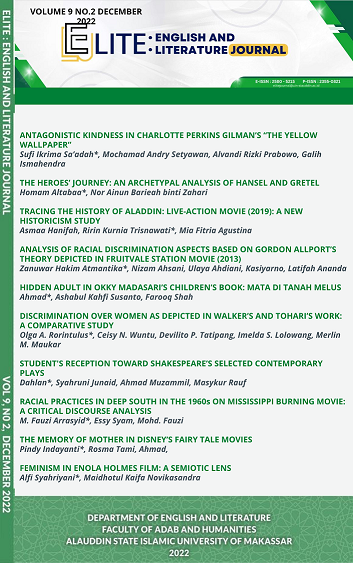RACIAL PRACTICES IN DEEP SOUTH IN THE 1960s ON MISSISSIPPI BURNING MOVIE: A CRITICAL DISCOURSE ANALYSIS
Abstract
This study analyzes racial practices in the movie Mississippi Burning, which portrays racism in the Deep South of America in the 1960s. This study used Jäger and Meier's Critical Discourse Analysis (CDA) and a descriptive qualitative method, which explains and reveals racial practices in the Deep South through Jim Crow Law and the Ku Klux Klan in the 1960s. This study's analysis data are the scenes depicting racism in the Deep South collected from the Mississippi Burning movie and the explanation of these pictures based on Jäger and Meier's CDA. After that, these data were analyzed by selecting and reducing it in finding racial practices in the Deep South, categorizing the data based on non-discursive practices with a table, and drawing a conclusion from the analysis. This study shows that Whites engaged in racial practices such as segregation, violence, lynching, intimidation, and burning Black churches. The Whites used these racial practices in this movie had the purpose of upholding Jim Crow Law, White supremacy, and preventing blacks from the vote and their advancement in larger communities.
Downloads
References
Alviniyanti, R. (2019). Racism on Spike Lee's Blackkklansman Movie: a Critical Discourse Analysis. Malang: Universitas Islam Negeri Maulana Malik Ibrahim Malang. http://etheses.uin-malang.ac.id/19240/1/15320132.pdf
Amelia, T. M., & Widyastuti. (2014). Critical Discourse Analysis of racism in Django Unchained Movie CRITICAL DISCOURSE ANALYSIS OF RACISM IN DJANGO UNCHAINED MOVIE. Language Horizon, 2(1). Retrieved from https://jurnalmahasiswa.unesa.ac.id/index.php/language -horizon/article/view/7528/7950
Arrasyid, M. F. (2022). Racism in the Deep South in the 1960s on Mississippi Burning Movie : a Critical Discourse Analysis Perspective. Pekanbaru: Universitas Lancang Kuning.
Creswell, J. W., & Poth, C. N. (1998). Qualitative Inquiry and Research Design Choosing Among Five Traditions. California: SAGE Publications. Retrieved from https://id.scribd.com/document/334593943/Qualitative-Inquiry-and-Research -Design-Choosing-Among-Five-Traditions
Etter, L. T. G. W., McElreath, D. H., & Quarles, C. L. (2005). The Ku Klux Klan: Evolution towards revolution. Journal of Gang Research, 12(3), 1–16. Retrieved from https://www.researchgate.net/publication/292621352_The_Ku_Klux_Klan_Evolution_towards_revolution
Fremon, D. K. (2000). Jim Crow Laws and Racism in American history. New Jersey. NJ : Enslow Publisher. Inc.
Fremon, D. K. (2014). The Jim Crow Laws and Racism in United States History. New Jersey. NJ : Enslow Publishers, Inc.
Hafizh, M. Al. (2016). RACISM IN THE POST-COLONIAL SOCIETY: A Critical Discourse Analysis to Jacqueline Woodson's Novels RASISME DALAM MASYARAKAT PASCAKOLONIAL: Sebuah Analisis Wacana Kritis terhadap Novel-novel Jacqueline Woodson. Humanus Jurnal Ilmiah Ilmu-Ilmu Humaniora, XV(2), 177–194. http://ejournal.unp.ac.id/index.php/humanus/index
Hartley, J. (2002). Communication, Cultural and Media Studies. London: Routledge. https://doi.org/10.4324/9781315225814-1
Haryatmoko. (2016). Critical Discourse Analysis (Analisis Wacana Kritis). Jakarta: Raja Grafindo Persada.
Ilahi., A., & Ruslan. (2019). The Improvement of Technology Ability for Teachers in Learning Activity to Increase Teachers Competencies in 21. Bandung: Universitas Pendidikan Indonesia. http://icerd2018.conference.upi.edu/wp content/uploads/sites/30/2018/12/Fullpaper_Anis-Ilahi.pdf
Maier, F., & Jäger, S. (2016). Analyzing Discourses and Dispositives: A Foucauldian Approach to Theory and Methodology. https://www.researchgate.net/publication/304676610_Analysing_discourses_and_dispositives_A_Foucauldian_approach_to_theory_and_methodology/citation/download
Pilgrim, D. (2012). What was Jim Crow - Jim Crow Museum - Ferris State University. Retrieved December 18, 2021, from Ferris State University, Jim Crow Museum of Racist Memorabilia website: https://www.ferris.edu/jimcrow/what.htm
Popham, J. N. (2016). KKK in the Civil Rights Era. Retrieved December 18, 2021, from Encyclopedia.com website: https://www.encyclopedia.com/politics/energy-government-and-defense-magazines/kkk-civil-rights-era
Rogers, R. (2004). An Introduction to Critical Discourse Analysis in Education. New Jersey: Lawrence Erblaum Associates Publisher. Retrieved from https://repository.dinus.ac.id/docs/ajar/An-Introduction-to-Critical-Discourse-Analysis-in-Education.pdf
Rusnalina, N. (2019). Racial Discrimination as seen in the Help Film by Tate Taylor Jambi : State Islamic University Suthan Thana Saifuddin Jambi. http://repository.uinjambi.ac.id/2792/1/AI140254_NOVIYANA RUSNANILA_BSI - Novi Yana.pdf
Simkin, J. (2020). Ku Klux Klan. Retrieved December 18, 2021, from Spartacus Educational website: https://spartacus-educational.com/USAkkk.htm
SimmsParris, M. (1998). What Does It Mean to See a Black Church Burning? Understanding the Significance of Constitutionalizing Hate Speech. University of Pennsylvania Journal of Constitutional Law, 1(1). Retrieved from https://scholarship.law.upenn.edu/jcl/vol1/iss1/4
Sugiyono. (2013). Metode Penelitian Kuantitatif, Kualitatif dan R & D. Bandung: Alfabeta.
Taufik, M., & Hasniar. (2016). Racism in 12 Years A Slave. English and Literature Journal, 03(01), 104–120. Retrieved from http://journal.uin-alauddin.ac.id/index.php/elite/article/view/3414
Wodak, R., & Meyer, M. (2009). Method of Critical Discourse Analysis. London: SAGE Publications.
Copyright (c) 2022 M. Fauzi Arrasyid, Essy Syam, Mohd. Fauzi

This work is licensed under a Creative Commons Attribution-NonCommercial-ShareAlike 4.0 International License.
Once an article was published in the journal, the author(s) are:
granted to the journal right licensed under Creative Commons License Attribution that allows others to share the work with an acknowledgement of the work's authorship.
permitted to publish their work online in third parties as it can lead wider dissemination of the work.
continue to be the copyright owner and allow the journal to publish the article with the CC BY-NC-SA 4.0 license
receiving a DOI (Digital Object Identifier) of the work.


